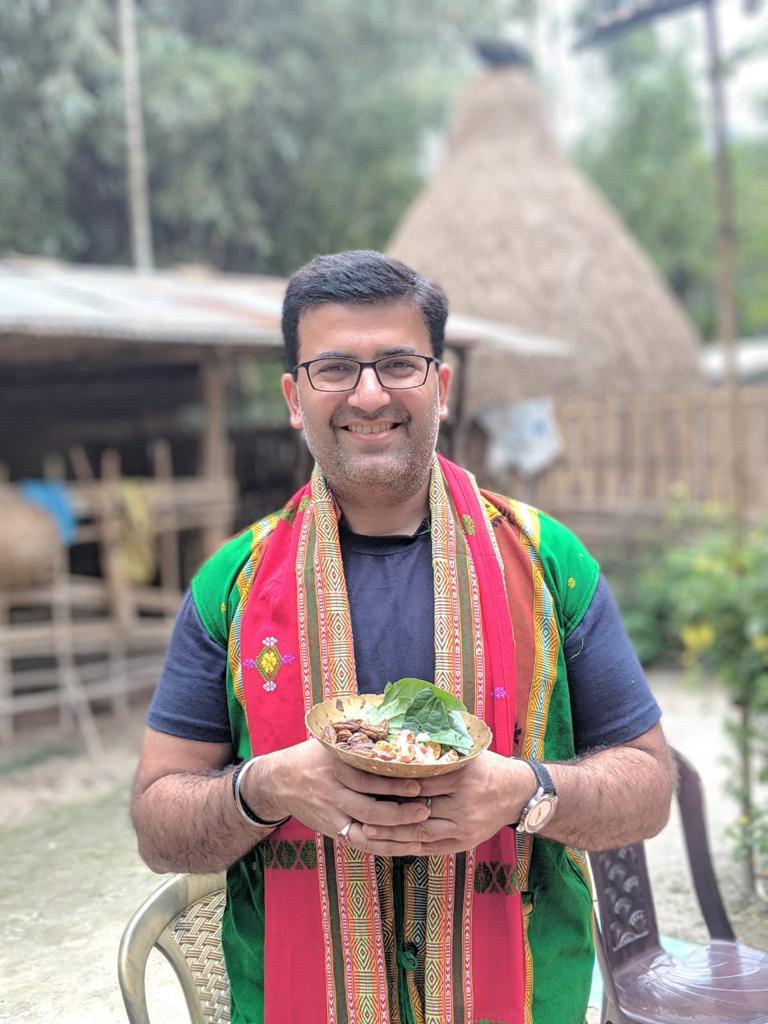
Starting this week onward Delhi Food walks brings you a new series named Ethnic Food Tour series that catalogues our food explorations across the diverse and rich tribal panorama of our country and beyond.
It commences with the rustic cuisine of the Rabha tribe from Assam. The Rabhas are the indigenous tribal groups from Assam who belong to the Indo-Mongoloid group of people. In Assam they are mostly settled in Goalpara, Kamrup, Kokrajhar, Udalguri, Baksa, Bongaigaon, Chirang, Sonitpur and Karbi Anglong districts. Agriculture, forest based activities and weaving are the mainstay of their traditional economy in general. Rabha women are skilled weavers who usually make their garments on their own. However due to the lack of market opportunities and external support their exquisite skill haven’t yet transformed into a thriving livelihood opportunity.
Getting back to their cuisine, rice is the staple food of the Rabhas who are completely non vegetarians. Local herbs and edible insects are the essential components of their daily diet. The simple and rustic dishes have minimum use of spices and condiments. Home brewed rice beer is widely consumed not only during special occasions but on a daily basis. Their meal is hued with unique earthy notes because all of their ingredients are primarily sourced from the forests and local farms. To discover more about them, we visited the Ujan Rabhapara village in Kakoijana in Bongaigaon district of Assam along with our brilliant hosts Chayanika, Sishir and Risha whose insights helped us to get familiar with the new culture with ease.

En route to the village, we stopped at a local household to try Assamese Jolpan. It is the umbrella term for the traditional breakfast dishes that the locals relish daily. The Assamese word ‘Jolpan’ refers to both breakfast and evening snacks that includes different forms of the wide variety of local rice that are eaten with jaggery and curd. Typically, the base ingredient includes any one of the following-kumol saul (uncooked but soaked rice), sira (flattened rice), moori (puffed rice) etc. One can customise it with banana, sweet boondi, rasgulla etc. It also includes other preparations like Pitha and Nadu. We tried the most elementary of them i. e the Sira Doi gur and boondi laddo. It was such a comforting combination.
After a short drive, we reached Ujan Rabhapara. Nestled amidst the green canopy of the Kakoijana forest expanse, this quaint sleepy village is home to the Rabhas. Kakoijana is the home to the endangered golden langur. Along with our hosts Chayanika, Sisir, Risha and Sanjib Sharma, we met the welcoming womenfolk from the village who had all gathered to cook a traditional Rabha meal for us. Since agriculture based activity are the mainstay of their livelihood, their cuisine is naturally dominated by the components from the same.

Hence it isn’t a surprise that it includes rice which is the staple, various local herbs, meats, fishes and insects. Bugs and insects like the silkworm, red ants, grasshoppers etc. are the delicacies that define their cuisine.

Another important element of the Rabha cuisine is the local rice beer called Chokoth, that is brewed in almost all households and is consumed almost daily. We tried it along with the genial locals. The taste profile of this alcoholic beverage was on the sweeter side. It is prepared by fermenting local rice along some herbs. After a period of 15 to 20 days they get ready for consumption.

The meal was prepared over the wood fire. Watching the herbs wilt in oil along with onions etc was a joyful experience although the addition of the silkworms or the red ants did make us apprehensive as it was our maiden attempt to try them. For the Rabhas these creatures are a nrich source of protein and so they are an important part of their regular diet. In no time with the collective efforts of the amazing womenfolks, the meal was ready. It was served in the local manner i.e. on the banana leaves. The meal comprised of the following- steamed rice, Mai Posung(steamed sticky rice with coconut) Skunkvine fritters, Silkworm with herbs, Posola di Kukura Mankho(country chicken cooked with banana stem), Taukam Bamshi(country chicken cooked with rice flour), Bakham(roasted pork), Hissa Pichi(Eggs of the red ants), Kekura bota(Crab Chutney), Guti aloo Aru Dhekiya Bhaji(baby potatoes with fiddlehead ferns) and Chokoth. Honestly some of the dishes like the silkworm and the dry fish chutney were an acquired taste that didn’t really catch our fancy although they weren’t at all weird. After finishing with the lunch we ate the Tamul and got ready for our departure. But what a humble experience it was with the simple and lively locals and of course the serene natural setting.
We are truly grateful to our amazing hosts for walking us through the fascinating landscape of the Rabha Cuisine with such enthusiasm and patience.
